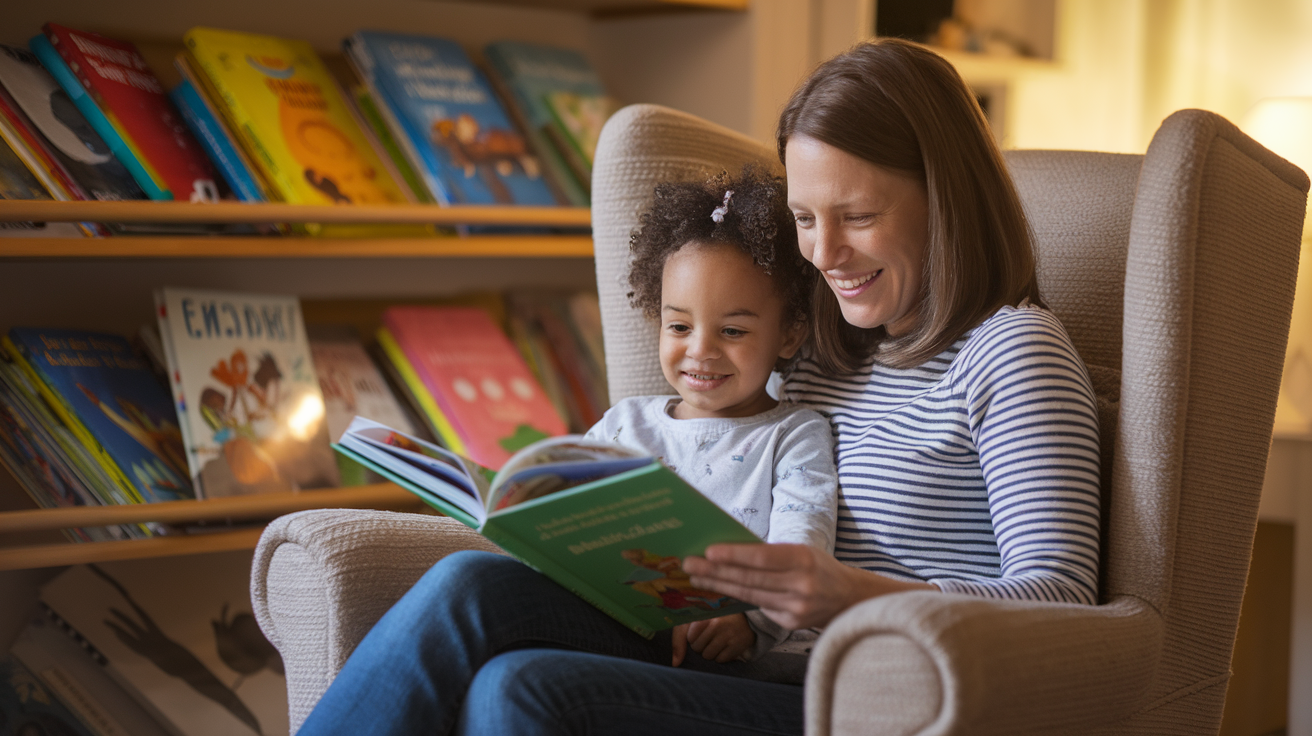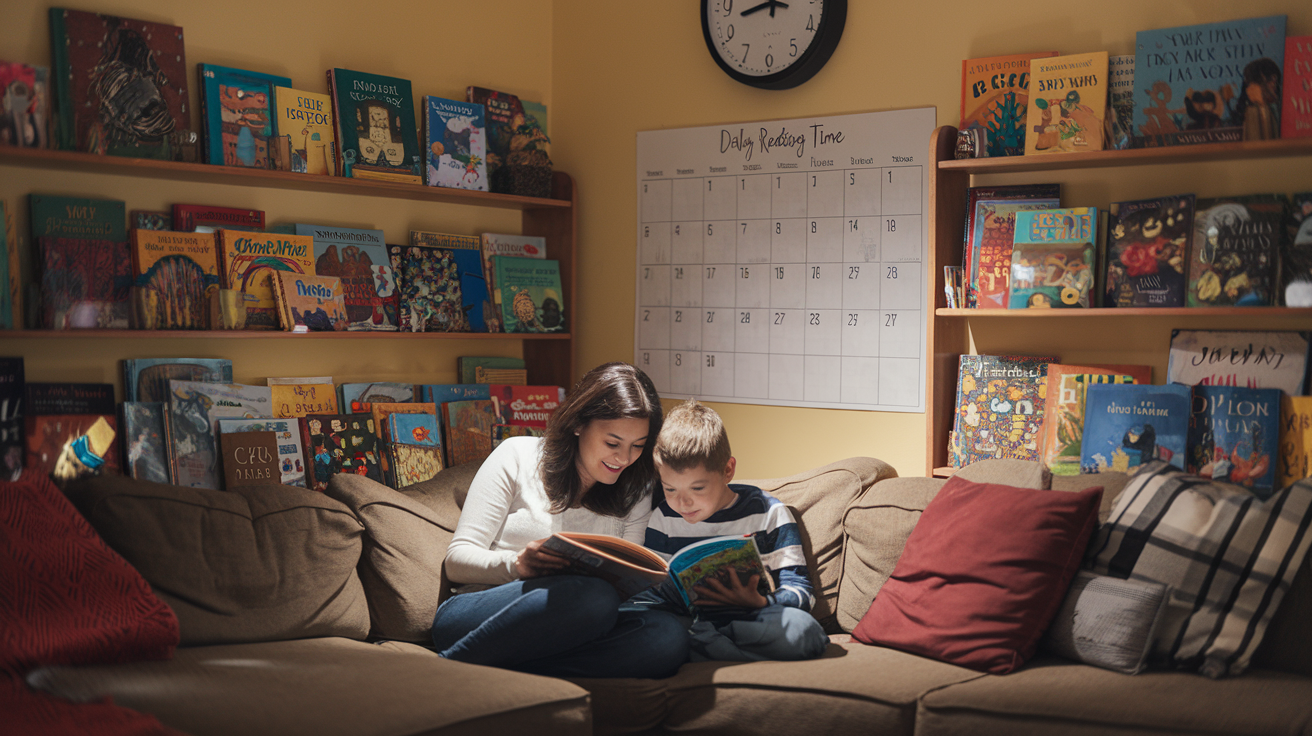7 Ways to Build a Daily Reading Habit in Young Kids
Are you tired of struggling to get your kids to read? 📚 Imagine a world where your children eagerly reach for books, their eyes lighting up with excitement at the prospect of diving into a new story. It’s not just a dream – it’s entirely possible with the right approach!
In today’s fast-paced, digital world, cultivating a love for reading in young children can seem like an uphill battle. But fear not! We’ve got you covered with 7 proven strategies to build a daily reading habit in your kids, nurturing lifelong learners without the dreaded nagging. From creating a cozy reading nook to leveraging technology wisely, these tips will transform your child’s relationship with books. Get ready to embark on a journey that will not only boost your child’s literacy skills but also strengthen your bond as you explore new worlds together through the magic of reading. 🌟
Let’s dive into these game-changing techniques that will make reading an integral part of your child’s daily routine. Whether you’re dealing with a reluctant reader or looking to enhance your budding bookworm’s habits, these strategies are designed to engage, inspire, and foster a genuine love for the written word.
Create a Reading-Friendly Environment

Designate a cozy reading nook
Creating a special reading area can significantly boost your child’s enthusiasm for books. A cozy nook dedicated to reading sends a clear message: this is a place for imagination and adventure. Consider these elements when setting up your reading nook:
- Comfortable seating (bean bags, cushions, or small armchairs)
- Soft blankets or throws
- Low shelves or baskets for easy book access
- Decorative elements like posters or wall decals with reading themes
Ensure proper lighting
Adequate lighting is crucial for a pleasant reading experience. Poor lighting can lead to eye strain and discourage reading. Here are some lighting tips:
- Natural light: Position the reading nook near a window if possible
- Task lighting: Use adjustable lamps for focused illumination
- Ambient lighting: Add soft, warm lights to create a welcoming atmosphere
Stock age-appropriate books
Having a diverse selection of books suitable for your child’s age and interests is key to maintaining their engagement. Consider the following:
| Book Type | Benefits |
|---|---|
| Picture books | Enhance visual literacy and vocabulary |
| Chapter books | Develop reading stamina and comprehension |
| Non-fiction | Expand knowledge and spark curiosity |
| Interactive books | Encourage hands-on engagement |
Minimize distractions
To help your child focus on reading, create an environment with minimal distractions:
- Choose a quiet area away from high-traffic zones
- Establish a “no screens” rule in the reading nook
- Use noise-cancelling headphones if necessary
- Keep toys and other non-reading items out of sight
By implementing these strategies, you’ll create an inviting space that naturally draws your child towards books and reading. This environment sets the foundation for developing a strong daily reading habit.
Lead by Example

Read in front of your children
Children are natural imitators, and they often mirror the behaviors they observe in their parents. By consistently reading in front of your kids, you’re setting a powerful example that reading is a valuable and enjoyable activity. Whether it’s a novel, newspaper, or even a cookbook, let your children see you engaged in reading throughout the day.
| Benefits of Reading in Front of Children |
|---|
| 1. Normalizes reading as a daily activity |
| 2. Demonstrates the importance of literacy |
| 3. Creates opportunities for discussion |
| 4. Encourages curiosity about books |
Share your favorite books
Enthusiasm is contagious. When you share your favorite books with your children, you’re not just introducing them to new stories – you’re showing them the joy and excitement that reading can bring. This approach helps create positive associations with reading and can spark their interest in exploring different genres and authors.
- Choose age-appropriate books from your childhood
- Explain why you love certain stories or characters
- Read aloud passages that you find particularly engaging
- Encourage your children to share their opinions about the books
Discuss interesting stories
Engaging in conversations about books helps children develop critical thinking skills and deepens their understanding of the material. By discussing interesting stories, you’re teaching them to analyze, interpret, and connect with the text on a personal level. This practice not only enhances their comprehension but also makes reading a more interactive and enjoyable experience.
Now that we’ve explored how to lead by example, let’s look at ways to establish a consistent reading routine that will further reinforce these habits.
Establish a Consistent Reading Routine

Set a specific time each day
Establishing a consistent reading routine starts with setting a specific time each day for reading activities. This predictability helps children anticipate and look forward to their reading time. Consider the following schedule options:
| Time of Day | Benefits |
|---|---|
| Morning | Fresh minds, sets a positive tone for the day |
| After school | Helps transition from school to home |
| Before bed | Calming activity, promotes better sleep |
Choose a time that works best for your family’s schedule and stick to it. Consistency is key in building a habit.
Start with short sessions
Begin with brief reading sessions to avoid overwhelming your child. Short, enjoyable experiences are more likely to create positive associations with reading. Here’s a suggested progression:
- Start with 5-10 minutes for younger children
- Aim for 15-20 minutes for older kids
- Allow flexibility based on the child’s interest and attention span
Gradually increase duration
As your child becomes more comfortable with the routine, slowly extend the reading time. This gradual approach helps build stamina and attention span. Tips for increasing duration:
- Add 2-3 minutes each week
- Use engaging books or series to naturally extend reading time
- Incorporate interactive elements to maintain interest
Use visual schedules or reminders
Visual cues can help reinforce the reading routine and make it a natural part of the day. Consider these ideas:
- Create a colorful reading calendar
- Use a daily routine chart with pictures
- Set up a special reading corner with a visible timer
- Use stickers or magnets to track reading days
By implementing these strategies, you’ll establish a consistent reading routine that nurtures a love for books and sets the foundation for lifelong learning.
Make Reading Interactive and Fun

Use voices for different characters
One of the most engaging ways to make reading interactive and fun is by using different voices for characters. This technique brings the story to life and captures children’s attention. Here’s a simple guide to help you master this skill:
| Character Type | Voice Suggestion | Example |
|---|---|---|
| Protagonist | Enthusiastic, clear | Harry Potter: brave and determined |
| Villain | Deep, menacing | Voldemort: cold and threatening |
| Sidekick | Upbeat, quirky | Ron Weasley: loyal and sometimes nervous |
| Wise mentor | Calm, authoritative | Dumbledore: wise and gentle |
Remember to exaggerate expressions and use body language to enhance the experience. This not only makes the story more enjoyable but also helps children distinguish between characters and understand their personalities better.
Ask open-ended questions
Engaging children with open-ended questions during reading sessions encourages critical thinking and deeper comprehension. Try these techniques:
- Ask “what if” questions to spark imagination
- Encourage predictions about what might happen next
- Discuss character motivations and feelings
- Relate story events to personal experiences
Act out scenes together
Transform reading time into an interactive performance by acting out scenes from the book. This kinesthetic approach to reading helps children:
- Better understand the story’s plot
- Develop empathy for characters
- Improve memory retention of the narrative
- Boost confidence in public speaking
Create reading-related games
Incorporating games into your reading routine can make the experience more enjoyable and reinforce learning. Here are some ideas:
- Word scavenger hunts based on the book’s vocabulary
- Character bingo using traits or actions from the story
- Create a board game inspired by the book’s plot
These interactive techniques not only make reading fun but also help develop crucial skills like comprehension, creativity, and critical thinking. As we explore these methods, children naturally become more engaged with books, setting the stage for a lifelong love of reading. Next, we’ll discover how technology can be leveraged wisely to further enhance the reading experience.
Leverage Technology Wisely

Use e-books and audiobooks
In today’s digital age, e-books and audiobooks offer exciting opportunities to engage young readers. These formats provide interactive features and accessibility that can complement traditional print books. Here’s how you can leverage them effectively:
- E-books:
- Adjustable font sizes for easier reading
- Built-in dictionaries for instant vocabulary learning
- Interactive illustrations that respond to touch
- Night mode for comfortable bedtime reading
- Audiobooks:
- Perfect for multitasking (e.g., during car rides)
- Excellent for developing listening skills
- Ideal for struggling readers to follow along with text
| Format | Advantages | Best Used For |
|---|---|---|
| E-books | Portability, Interactive features | Independent reading, Visual learners |
| Audiobooks | Hands-free, Professional narration | Auditory learners, Busy families |
Explore educational reading apps
Educational reading apps can make learning to read a fun and engaging experience. These apps often gamify the reading process, keeping children motivated and excited about their progress. Some popular features include:
- Personalized reading recommendations
- Progress tracking and rewards systems
- Interactive stories with voice recognition
- Phonics games and exercises
When selecting apps, look for those that align with your child’s reading level and interests. Remember to balance app usage with traditional reading methods for a well-rounded approach.
Set screen time limits
While technology can be a valuable tool in nurturing reading habits, it’s crucial to set appropriate limits. Excessive screen time can negatively impact a child’s attention span and sleep patterns. Consider these guidelines:
- Establish clear rules for daily screen time
- Use parental controls to enforce limits
- Encourage a mix of digital and print reading
- Create tech-free zones, especially in bedrooms
By wisely incorporating technology into your child’s reading routine, you can harness its benefits while avoiding potential drawbacks. This balanced approach will help foster a love for reading that extends beyond screens and into all aspects of your child’s life.
Reward Progress, Not Performance

Create a reading tracker
Tracking your child’s reading progress is an excellent way to encourage consistent reading habits. A visually appealing reading tracker can make the process more engaging and motivating for young readers. Here are some creative ideas for reading trackers:
- Bookmark progress meter
- Reading tree with leaf stickers
- Book-shaped chart with colorful stickers
- Digital app with fun avatars and badges
| Tracker Type | Benefits | Best For |
|---|---|---|
| Physical | Tangible, visible progress | Younger children |
| Digital | Easily shareable, interactive | Tech-savvy kids |
| Combination | Versatile, appeals to different preferences | Families with multiple children |
Celebrate milestones
Acknowledging your child’s reading achievements is crucial for maintaining motivation. Set realistic milestones based on your child’s age and reading level, such as:
- Number of books read
- Minutes spent reading daily
- Completing a book series
- Reading books from different genres
When a milestone is reached, celebrate with enthusiasm! This positive reinforcement will associate reading with joy and accomplishment.
Offer non-material rewards
While material rewards can be tempting, non-material rewards often have a more lasting impact on a child’s intrinsic motivation to read. Consider these ideas:
- Extra playtime or screen time
- Special outing with a parent
- Choosing the next family activity
- Reading-related privileges (e.g., staying up late to finish a book)
Focus on effort and enjoyment
Shift the focus from performance metrics to the effort and enjoyment your child experiences while reading. Encourage them to share their favorite parts of a story, discuss characters they relate to, or express how a book made them feel. This approach nurtures a love for reading that goes beyond just completing books or meeting targets.
Connect Reading to Real-Life Experiences

Choose books related to upcoming events
Selecting books that align with upcoming events in your child’s life can make reading more relevant and exciting. This approach helps children connect literature to their real-world experiences, enhancing comprehension and interest.
Here’s a table of event-book pairings to inspire you:
| Event | Book Suggestion |
|---|---|
| First day of school | “The Kissing Hand” by Audrey Penn |
| Family vacation | “Oh, the Places You’ll Go!” by Dr. Seuss |
| New sibling arrival | “The New Baby” by Mercer Mayer |
| Halloween | “Room on the Broom” by Julia Donaldson |
| Moving to a new home | “The Berenstain Bears’ Moving Day” by Stan Berenstain |
Visit places mentioned in stories
Bringing stories to life through real-world experiences can significantly boost a child’s enthusiasm for reading. After finishing a book, plan a trip to a location featured in the story. This could be:
- A local museum after reading a historical fiction
- A zoo after an animal-themed book
- A park or nature reserve after a wilderness adventure story
Cook recipes from favorite books
Many children’s books feature food prominently. Engage your child by preparing recipes mentioned in their favorite stories. This activity not only reinforces reading comprehension but also teaches valuable life skills. Some ideas include:
- Making “Green Eggs and Ham” after reading Dr. Seuss
- Baking cookies inspired by “If You Give a Mouse a Cookie”
- Preparing a “Mad Hatter’s Tea Party” from Alice in Wonderland
Encourage writing or drawing inspired by readings
Stimulate creativity by encouraging your child to express their thoughts about the books they read through writing or drawing. This can take various forms:
- Creating an alternative ending to a story
- Drawing a favorite scene or character
- Writing a letter to a book character
- Designing a new book cover
These activities help children internalize the stories they read, fostering a deeper connection to literature and nurturing their imagination.

Building a daily reading habit in young children is a powerful way to nurture lifelong learners and foster a love for knowledge. By creating a reading-friendly environment, leading by example, and establishing consistent routines, parents and caregivers can set the foundation for a lifetime of literary exploration. Making reading interactive and fun, while wisely leveraging technology, can further enhance the experience and keep children engaged.
Remember, the goal is to cultivate a genuine interest in reading, not to force it. Reward progress rather than performance, and connect reading to real-life experiences to make it more meaningful. By implementing these strategies, you can help your child develop a daily reading habit that will serve them well throughout their lives, opening doors to endless possibilities and adventures through the power of books.
















